
Resilient Urban Infrastructure: Adapting Coastal Cities in Southeast Asia to Climate Change
The steady rhythm of climate change is impossible to ignore, especially for Southeast Asia's coastal cities caught in the crosshairs. Sea levels are climbing, and wild weather patterns have become our everyday reality; it's clear that urban resilience isn't just a buzzword—it's an imperative.
Dive with me into this blog post, where we'll uncover why adapting infrastructure is way more than an option—it's vital survival gear for these exposed cityscapes. Let's take a closer look at some cutting-edge tactics, reinventing how we craft our cities so they can stand strong against nature's curveballs brought on by global warming.
Strategies for Urban Resilience in Southeast Asian Coastal Cities
So, you're curious about urban resilience? Well, as someone who crafts words for a living and dives deep into the heart of city survival stories, I've got to tell you—it's critical. Especially for those coastal cities in Southeast Asia, where climate change isn't knocking; it's banging down the door. Ever seen how a tenacious town takes on Mother Nature's tantrums? It's pretty awe-inspiring stuff! It screams that we need to get our act together.
We aren't talking some dead-dull diagrams here—urban resilience plans are peeking into what makes people tick when they refuse to give up. We're looking at mixing tough-as-nails infrastructure with something softer like getting folks involved or giving nature a bit of TLC. Take Jakarta's jam-packed roads or Manila's lively beaches—they're more than just spots on a map; they pulse with life for millions!
Now comes the million-dollar question: How do we protect these hubs from disaster? Step one is digging deep into risk assessments that predict disasters before chaos hits us sideways. Next up—we wire communities with alarms ahead of time, so nobody gets caught off guard by calamities lurking around the corner.
Picture this—a metropolis buzzing not just because cars are honking but also because rooftops have gone green, and wetlands aren't hidden gems anymore; instead, everybody cheers them on against floods and storms! And talk about rolling with punches—in Bangkok right now, there's chatter over buildings playing buoyancy games during deluges—how cool would floating offices be?
Don't know about you, but all this talk has me rooting even harder for innovations keeping pace alongside water levels rising inch by tricky inch... Let's not forget the incredible impact that community-led projects can have. Right in Ho Chi Minh City, folks from the neighborhood are rolling up their sleeves to become guardians of their own streets, diving into activities that beef up resilience. It's essential for these urban communities—you know where real life pulses through every corner—to do more than just watch from the sidelines; they've got to be knee-deep in shaping a tough-as-nails future.
Education is key when it comes to nurturing this spirit of toughness and tenacity. When we shine a light on what climate change really means and lay out its consequences like cards on a table, we're giving people power—the kind of power that comes with knowledge—to choose wisely for themselves and others around them. Think about it: how can anyone brace for changes if they're clueless about what's coming or don't know squat about staying ahead? We've got to bring this talk beyond those stuffy boardrooms—it belongs in classrooms buzzing with curious minds and at dinner tables covered with tonight's meal plans too.
Climate Change Impacts on Southeast Asia's Urban Infrastructure
Ever think about the gritty realities of Southeast Asia's cityscapes? Picture this: roads not just cracking but giving way, drainage systems that can't handle a good downpour. These sights aren't merely annoying—they're big, flashing signs of an approaching storm.
Sea levels don't just creep up; they relentlessly climb, bringing with them more punishing storms than we've ever faced before. Forget guesses and forecasts—this is what folks are living through right now in these parts.
Take the Mekong Delta, for example. Rising saltwater isn't some distant threat—it's lapping at our doorsteps, endangering essential crops and wreaking havoc on buildings and pavements alike. The very earth is rebelling against us; it's shifting beneath our feet into something unrecognizable—not exactly friendly to those trusty old designs we rely on every day.
And if you thought that was bad enough, let me tell you about heat stress—the silent enemy lurking around high-rise corners. Those concrete jungles scattered across Southeast Asia morph into ovens when night falls—and guess what? The oven stays hot even after dark! We're talking serious risks here for everyone sweating it out—especially those without a cool place to escape to.
Shorelines are disappearing faster than ever, wiping out the bustling beach scenes we used to know. Think about it—have you strolled along a coastal stretch and watched your sandy prints get swallowed by the tide? Well, imagine that happening to entire cities at a staggering speed.
Now let's talk bricks and mortar—or should I say roads and bridges? It goes way beyond slapping down some asphalt. We've got to think ahead because Mother Nature's rule book is getting rewritten as we speak. Our built world needs an upgrade if it wants any chance of keeping up with climate change's merciless march.
Conclusion
Southeast Asia's coastal cities are up against a real battle with the rising tides and wild weather, but there's light at the end of the tunnel. Crafting tough city bones isn't just about dodging climate curveballs; it's putting money on tomorrow—betting that these buzzing hubs will keep their spark alive. By rolling out clever new ways to bolster our foundations, these urban giants stand tall as testaments to what we can dream up when we're looking out for our common digs.
Sure, navigating this road ain't easy by any stretch—but if we band together? We've got a shot at making Southeast Asia's waterfronts unbreakable and eco-friendly for folks down the line.






Terms & Conditions
Subscribe
Report
My comments